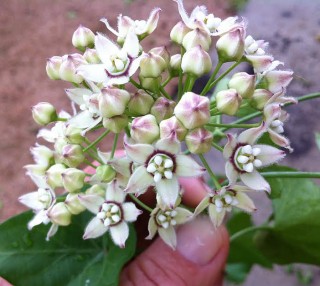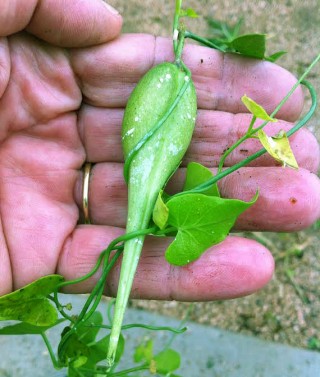
Flowers of milkweeds are beautiful up close. The stamens and pistils are fused to form a column in the center of the flower. The column is surrounded by a ring of five “hoods.” In this species the hoods look like glistening pearls. This climbing milkweed has taken up residence in the Butterfly Garden. Karen L. P. Benson Photo.
If you have ever planted any garden, you know about weeds. Weeds are unwanted plants that take advantage of the rich soil and abundant water you have provided. They are the ultimate opportunists.
One of the most common weeds is a wild morning glory vine. It is usually called “bindweed” and bind is what it does best. It wraps around the stems of your chosen plants (and anything else it can grab) and makes tight knots of leaves, vines and purple flowers. Pretty soon all you see is a mound of bindweed.
So it surprised no one that we had bindweed in the Flournoy Park Butterfly Garden. We volunteer weeders just knuckled down and pulled it out.

Milkweeds produce pods like this one. Each pod is full of silk-covered seeds. The dry pod will split open releasing hundreds of the fluffy seeds. The seeds can be carried by the wind for miles to new homes. This is probably how the climbing milkweed got in the Butterfly Garden. Karen L. P. Benson Photo.
Recently, we came across another weedy vine in the Butterfly Garden. It had heart-shaped leaves that somewhat resembled bindweed’s leaves. But its long, stringy vines seemed tougher than bindweed vines, and when cut, they leaked a milky sap. Clearly, this new weed was a climbing milkweed.
As we pulled the climbing milkweed off of the garden plants, we rolled up the vines like coils of wire. Some of the vines were almost 20 feet long!
Then we noticed the flowers. The blooms were in rounded bunches, called umbels. Each umbel had 10 to 20 individual flowers in it. And each flower was a classic milkweed flower.
A milkweed blossom is distinctive in that in the center of the petals is a column ringed with five curved structures called hoods. In some milkweed species the hoods look like extra petals and in others they are ball-shaped. These little hoods probably serve as visual attractants for pollinators.
Since each flower was only about a half inch across, I got a magnifier to get a better look. The magnified blossom was astoundingly beautiful. The pearly hoods glistened almost like they had little light bulbs inside them. And the petals were white with deep purple stains at their bases. But most amazing was that the entire surfaces of the petals were covered with tiny hairs. Under magnification they looked almost fuzzy, and the edges appeared to be delicately fringed.
A magnifying glass or a microscope can make any living thing more impressive. It is no wonder that the first tool a naturalist-in-training is given is a pocket magnifier. Any outdoors person should have one. A pocket magnifier makes a great Christmas stocking-stuffer for everyone!
Now that I had had a glimpse into the wonder of a milkweed flower, I decided to learn more about this family of plants. It is a large family (actually a sub-family) of over 2000 species. All have that milky sap which can be toxic in a few species. And all have those unusual flowers.
The stamens and the pistils are fused into a column in the center of the flower. The column is ringed by those five hoods. This arrangement is called a crown.
Pollination in the milkweed family is unusual. The stamens make pollen, but instead of being in individual grains, it is packed into special pollen sacs, called pollinia. When an insect lands on the milkweed flower’s crown, its feet slip into a groove between two adjacent stamens. As the insect flies off, its foot hooks a thread-like connector to the stamens and a pair of pollinia is pulled out. When the insect visits another flower, the pollinia are slipped into a pocket on the column.
I wondered if I could duplicate this procedure. Using a needle as an artificial insect leg, I was able to pull out the pollinia. Under the magnifier I could see that the structure resembled a tiny wishbone. The pollen sacs were the “wings” of the wishbone. Like a wishbone, it had a front and back side. This means it could be slipped into the pocket on the column frontward or backward. I didn’t have much luck getting the pollinia in the pocket either way. Perhaps insects have a special technique for inserting the pollinia.
I read that botanists believe that if the pollinia are inserted backwards, the pollen won’t be able to fertilize the ovules. No fertilization means no milkweed seeds, no seed pods. Perhaps this is the reason there are so few milkweed pods on any given milkweed plant. Considering how many flowers are in each umbel, you would think there should be more pods.
Fortunately, milkweeds have an advantage in that each pod holds a large number of seeds. These seeds are covered with feathery filaments which catch the breeze and fly the seeds to new homes. Thus they are distributed far and wide.
This is probably how the climbing milkweed got into the Butterfly Garden in the first place. Climbing milkweed (Sarcostemma cynanchoides) is not common in south Texas. Its range is said to be only in the western half of Texas. But with a good wind, a milkweed seed could make it easily. You may be seeing climbing milkweed soon in your own garden!
ESSAY BY KAREN L. P. BENSON
If you would like to receive Karen’s Nature Essays by email, please signup here.
